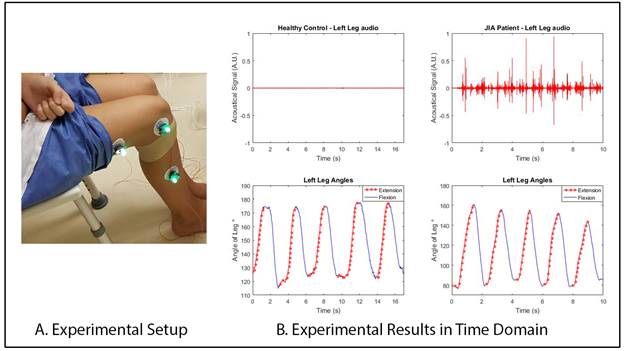Session Information
Session Type: Abstract Submissions
Session Time: 5:30PM-7:00PM
Background/Purpose: Juvenile Idiopathic Arthritis (JIA), the most common chronic rheumatic disease occurring in childhood, is an important cause of disability. Despite the persistence of disease activity in most patients, a marked improvement in functional outcome has been achieved recently – attributable to advances in diagnosis and new treatment regimens. Despite these improvements, 5-10% of patients still have serious functional disability five years post diagnosis. Advances in the standardization of clinical diagnostics and further refining of the treatment regimen will likely further improve outcomes. One principal difficulty in standardizing the diagnosis of JIA is the lack of specific biomarkers for the disease and its concomitant progression. We investigated measuring joint sounds as a non-invasive biomarker of joint health in JIA.
Methods: The advent of wearable technologies has ushered a new era of possibilities for continuous health monitoring. Joint acoustic emissions measured via contact microphones (i.e., accelerometers) are one unobtrusive method of capturing information regarding the underlying, physiologic processes of a joint. This information can readily be incorporated into a wearable platform. These emissions result from changes in the biomechanics of the joint. Internal friction between the articulating structures in the knee create various frequencies of vibrations that can be detected at the surface of the knee. The persistent inflammation in JIA provides opportunity for utilizing this technology to diagnose and monitor the condition. Proof of concept recordings were performed from two subjects with this device.
Results: The first subject was a 12-year-old male with systemic JIA; a healthy control subject was age and sex matched for comparison. The subjects’ knee sounds were recorded using a custom hardware consisting of LED motion tracking and accelerometers for vibration detection (Figure 1A). Subjects performed five flexion/extension cycles with the recording apparatus in place. In Figure 1B, the bottom panels show oscillating graphs representing the angle of the knee, while the top panels show the filtered sound profile. The JIA subject’s plot appears more chaotic with a periodicity to the sharp peaks.
Conclusion: Measuring acoustic emissions from joints affected by JIA shows promising differences which encourage further development and refinement of this acoustic recording system for the diagnosis and monitoring of JIA.
To cite this abstract in AMA style:
Whittingslow D, Semiz B, Ponders L, Wiens A, Inan O, Prahalad S. Analysis and Implications of Non-Invasive Knee Acoustical Emissions in Juvenile Idiopathic Arthritis [abstract]. Arthritis Rheumatol. 2017; 69 (suppl 4). https://acrabstracts.org/abstract/analysis-and-implications-of-non-invasive-knee-acoustical-emissions-in-juvenile-idiopathic-arthritis/. Accessed .« Back to 2017 Pediatric Rheumatology Symposium
ACR Meeting Abstracts - https://acrabstracts.org/abstract/analysis-and-implications-of-non-invasive-knee-acoustical-emissions-in-juvenile-idiopathic-arthritis/

